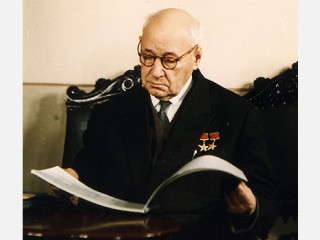
Andrei Tupolev biography
Date of birth : 1888-11-10
Date of death : 1972-12-23
Birthplace : Pustomazovo, Russia
Nationality : Russian
Category : Science and Technology
Last modified : 2010-11-30
Credited as : Aeronautical engineer, army officer,
The Russian aeronautical engineer and army officer Andrei Nikolaevich Tupolev was the leading designer of large and heavy aircraft in the former U.S.S.R.
Andrei Tupolev was born on Nov. 10, 1888, in the village of Pustomazovo (now Kalinin Oblast). In 1909 he entered the Moscow Higher Technical College, studied under Nikolai Egorovich Zhukovskii, the "father of Russian aviation, " built wind tunnels as a student, and participated in the college's aeronautical club. It is believed that he received further training under Hugo Junkers, who set up an aircraft construction facility in Fili, a suburb outside of Moscow, under a 1922 Russo-German agreement. After graduation Tupolev assisted Zhukovskii in organizing the Central Aerohydrodynamics Institute, where he was assistant director from 1918 to 1935 and headed its design bureau beginning in 1922.
Tupolev's early work centered on wind tunnels and training gliders. He became a pioneer in the construction of all-metal aircraft fabricated out of Duralumin. In the course of his career Tupolev designed well over 100 planes, from his first, the ANT-1, a light transport made mainly of wood, to the supersonic jet transport, the TU-144, the world's most sophisticated commercial aircraft. Some of his more significant earlier designs are the two-seater ANT-2, constructed in 1924 completely out of Duralumin; the TB-1, a two-engine bomber with a range of 625 miles and a speed of 138 miles an hour; and the highly successful four-engine heavy bomber, the TB-3, weighing over 43, 000 pounds and capable of carrying over 2 tons.
Tupolev headed the design bureau that produced an unusual 40-ton plane, the Maksim Gorkii, which carried six engines mounted on its wings and two atop the fuselage. Within the plane provision was made for a telephone switchboard, telegraph center, radio station, printing facilities, photographic laboratory, and motion picture projectors. With much fanfare the Maksim Gorkii made a trial flight in June 1934. The following year it collided with another craft, resulting in the death of 35 people; it was never replaced.
In 1936 Tupolev visited the United States and Germany to study methods of aircraft construction, and the following year he was accused of selling to Germany blueprints of a plane that supposedly became the Messerschmitt 109 fighter. He was subsequently labeled an "enemy of the people" and sentenced to be executed. While in prison he designed the TU-2, a twin-engine dive bomber. For his role in producing the Soviet Union's sole new bomber of World War II, he was released from prison. In 1944 he was the Soviet Union's chief designer of heavy bombers. After the forced landing of three Boeing B-29 Superfortresses in 1944 in the Soviet Far Eastern Territory, Tupolev produced a Russian version of this American bomber.
In the postwar period, Tupolev's best designs include the TU-104, a twin-jet transport used extensively in the U.S.S.R.; the TU-114, a double-deck, four-engine turbo-prop passenger plane; and the TU-144, the Soviet entry in the supersonic-transport field. On Dec. 31, 1968, the TU-144 lifted off in a test flight—the first supersonic transport to become airborne. It was capable of speeds up to 1500 miles an hour with a range of 4000 miles.
Tupolev was made a lieutenant general in the technical branch of the Red Army during World War II. He became a full member of the Soviet Academy of Sciences in 1953 and served on many governmental agencies.
He died in 1972.
There is no definitive work on Tupolev in Russian or English. Scattered references in Soviet newspapers, aviation journals and surveys of Soviet aviation provide some information on his contributions. However, a fine section on the history of Soviet military aviation appears in William Green and John Fricker, The Air Forces of the World: The History, Development and Present Strength (1958). Material on Tupolev's aircraft can be found in Robert A. Kilmarx, A History of Soviet Air Power (1962), and Asher Lee, The Soviet Air Force (1962).
















